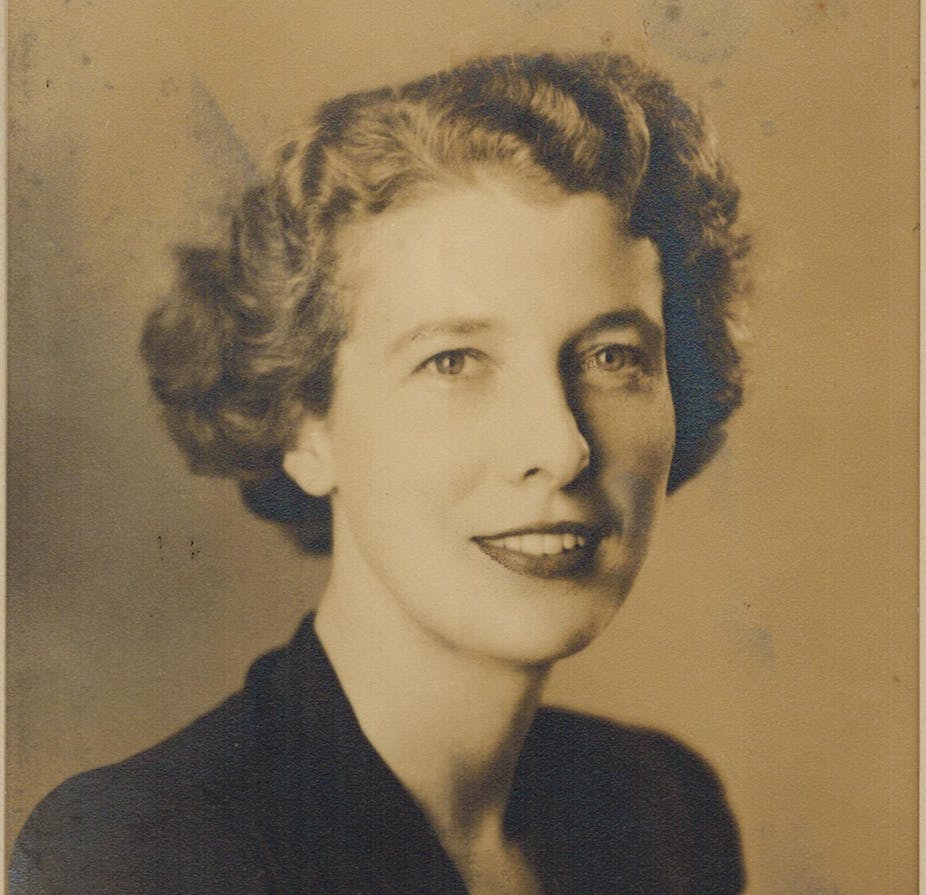When the Yorkshire Evening News reported on an address delivered by 25-year-old physicist Florence Bell at a scientific conference held in Leeds in 1939, it wasn’t her science that made the headlines, but simply the fact that she was a woman doing science.
What neither the writers who came up with the headline “Woman Scientist Explains”, nor their readers could have known was that, in the course of her PhD research, this particular woman scientist had quietly laid the foundations for one of the biggest landmarks in 20th century science: the discovery of the structure of DNA.
With chapters describing the structure of protein fibres in jellyfish, shark fins and hair, Bell’s PhD thesis might seem an unlikely milestone in biology. But among these, one chapter stands out. This part of Bell’s work describes how X-rays could be used to reveal the regular, ordered structure of a biological fibre that at the time was called “thymonucleic acid”.
Today thymonucleic acid is known by the more familiar name of “deoxyribonucleic acid”, or DNA. Bell’s X-ray method was to become a vital tool in eventually revealing the now well-known double helix shape of DNA that allows it to copy genetic information.
Bell, who was born in 1913 in London, was one of a growing number of female students who studied natural sciences at Girton College at the University of Cambridge.
After leaving Cambridge in 1936 Bell first spent a short period in Manchester with Lawrence Bragg who, together with his father William, had received the 1915 Nobel prize in physics. The pair had shown how X-rays could be used to reveal the arrangement of atoms and molecules in simple crystals such as salt.
Read more: Rosalind Franklin still doesn't get the recognition she deserves for her DNA discovery
In 1937, Bell moved to the University of Leeds to take up a post as a research assistant with the physicist William Astbury who was applying the Braggs’ methods to the study of wool and other biological fibres.
Astbury’s X-ray studies of the proteins in wool fibres revealed that their structure was like a molecular chain, or necklace, formed by joining together smaller chemicals called amino acids. This molecular necklace could be stretched or compacted.
Although this may not seem significant, the fact these proteins could change shape proved to be crucial in understanding how they functioned. Astbury’s studies of wool would transform our understanding of biology at a molecular level.

Emboldened by his success with wool, Astbury began to cast his net wider to study other biological fibres. For this, he needed another pair of hands skilled in this new method of X-ray analysis.
Enter Florence Bell. With her sharp intellect and willingness to challenge his ideas, Astbury called Bell his “devil’s advocate”. He gave her the task of using X-rays to study DNA.
Taking an X-ray image was not easy. It required ten-hour exposure times, working in a darkened room in close proximity to high electrical voltages and very hot X-ray tubes. But Bell’s skill and tenacity paid off and in 1938, based on the X-ray images she had taken, she and Astbury proposed an early model of the DNA structure. This model later gave James Watson and Francis Crick a vital foothold when they began their own work on DNA.
Sadly however, just as it was gathering pace, Bell’s work on DNA was brought to an abrupt halt. In 1941, she was summoned for military service in the Women’s Auxiliary Air Force. According to one of her sons, Chris Sawyer, during her service she did early work on the development of radar (radio detection and ranging).
Astbury, meanwhile, begged the War Office that Bell be allowed to remain in his lab, but his pleas were in vain. The University of Leeds even kept her post open, but Bell never returned.

Having married an American serviceman, Bell emigrated to the US where she worked as an industrial chemist, before giving up her career to look after her four children. It is presumably in reflection of these changed circumstances that when she died in 2000, her occupation on her death certificate was recorded as “housewife”.
Sawyer recalled that later in her life his mother liked to claim that one of her greatest achievements was to have been the first woman in the Royal Air Force to wear trousers. But Bell was being modest.
With her X-ray studies of DNA, Bell had not only given Watson and Crick a vital foothold, but had also paved the way for Rosalind Franklin, whose own work in this field was key in helping Watson and Crick to solve the structure of the genetic material.
Franklin now has an award-winning portrayal by Nicole Kidman in the West End play Photo 51, a Mars Rover named in her honour, and a new novel about her – she is thankfully no longer quite the “dark lady of DNA” she once was. Perhaps it is now Florence Bell who truly deserves this title.
Read more: Watson and Crick took all the glory, but there’s a forgotten hero of the double helix
The story of Florence Bell is told in the revised edition of Kersten’s book, The Man in the Monkeynut Coat: William Astbury and How Wool Wove a Forgotten Road to the Double Helix, which will be published in paperback by Oxford University Press in March 2022.

